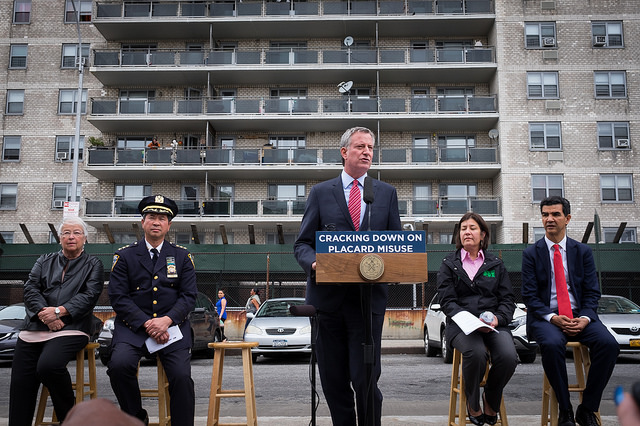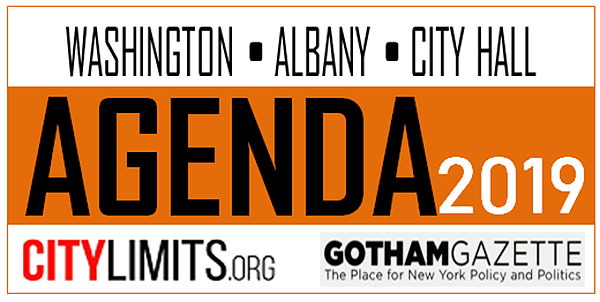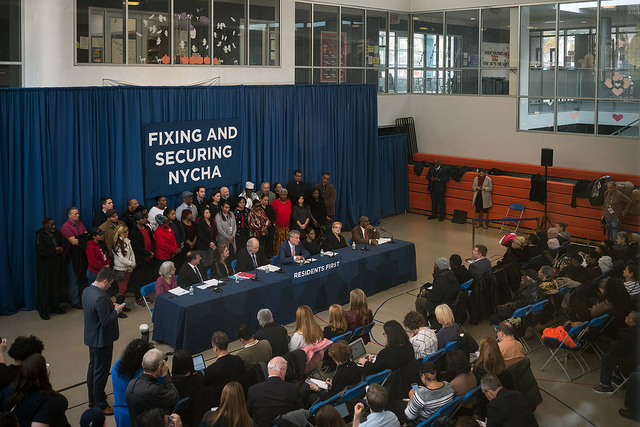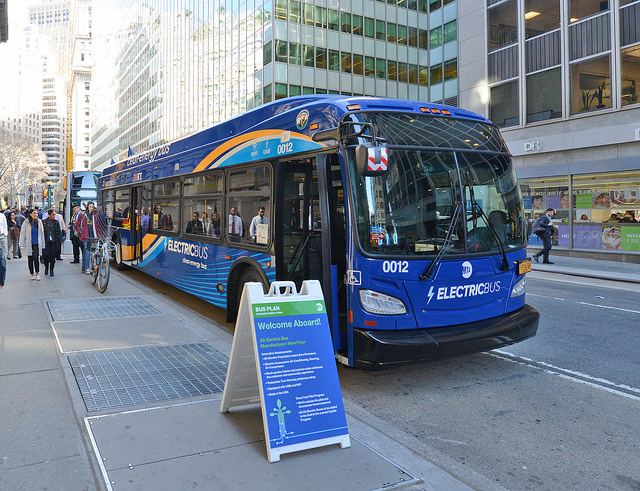Placard Abuse is Corruption; 2019 is The Year to End It

De Blasio pledging a placard crackdown (photo: Edwin J. Torres/Mayor's Office)
This is part of AGENDA 2019, a joint Gotham Gazette-City Limits project
Find the rest of the series here
In New York City, the people are betrayed by many conspiring groups. Dishonest drivers get away with breaking laws by displaying parking placards, or “courtesy cards,” or even safety vests and handwritten notes – pretty much anything that demonstrates the right connections to the placard class. The police misuse their “discretion” to operate a favor-trading system they euphemistically refer to as “professional courtesy.” Sham oversight offices and district attorneys participate in the system, too. And the politicians spread placards around and avoid oversight to buy support.
Those who abuse the system may try to rationalize it. They might call it a job perk or a victimless crime. Nonsense. And as the city becomes denser, worsening placard corruption has more impact on safety and quality of life. It impedes emergency responses by congesting streets and sidewalks and by blocking fire hydrants and turning movements at critical locations. It fills loading zones and inflames congestion. It destroys transit service by blocking bus lanes and bus stops. It makes streets unsafe by forcing people on bicycles into traffic and blocking sight lines at intersections. It makes sidewalks uncomfortably narrow and physically destroys them.
It has even seized public park land and entire streets just to provide more free parking for the placard class. It stomps on the rights of people with disabilities who cannot use crosswalks and sidewalks or safely board buses from the curb. And when the police turn a blind eye to illegally parked vehicles, it creates a vulnerability for terrorism. NYPD Counterterrorism knows about the risk of car bombs being overlooked with a placard, but the illicit parking perks consistently prove to be a higher priority than protecting the public.
Placard corruption itself is real criminal misconduct. But we are also concerned that it is often a missed warning flag for much worse criminal activity. Internal Affairs knows, for example, that police placards are attractive for drug smuggling. Failing to maintain discipline also allows the bad apples to remain on the force until they do something heinous, rather than identifying and removing them when a pattern of misconduct emerges.
With our streets already overrun with placard corruption, Mayor de Blasio made the decision last year to hand out an extra 50,000 placards. There was immediate backlash to what appeared to be an effort to buy political support from teachers, and the mayor found himself on the defensive. To save face, he announced a fake crackdown on placard corruption.
On May 24, 2017, he stood at a press conference in the Bronx with the NYPD at his side to announce the city’s new zero tolerance policy. It was empty rhetoric. There was never any real enforcement.
Even before the press conference, it seemed clear the administration was not really serious. The previous week, the mayor's press secretary responded to one of our tweets of a traffic enforcement agent refusing to write a ticket to a vehicle with an illegal license plate cover because there was a NYPD placard on the dashboard by saying: "you tweet at me an awful lot. I read almost none of them. But from what I gather, you'll care about an event we do next week in the BX."
The "crackdown" was designed from the start to minimize any real impact. It added more staff at taxpayer expense, but did not require the tens of thousands of existing officers and enforcement agents who aggressively blanket every part of the city in a half-billion dollars in tickets every year to simply provide honest enforcement. But the lack of real enforcement turned out to be even worse than we expected.
 Over the course of an entire year, a grand total of 89 vehicles were towed, according to testimony at a City Council oversight hearing (which we believe included plenty of perjury by top NYPD officials). That was with new towing capacity and 100 additional enforcement agents that we are all paying for. Eighty-nine vehicles using placards to park illegally in ‘No Standing’ zones could be towed out of Battery Park City and the Financial District in a single afternoon.
Over the course of an entire year, a grand total of 89 vehicles were towed, according to testimony at a City Council oversight hearing (which we believe included plenty of perjury by top NYPD officials). That was with new towing capacity and 100 additional enforcement agents that we are all paying for. Eighty-nine vehicles using placards to park illegally in ‘No Standing’ zones could be towed out of Battery Park City and the Financial District in a single afternoon.
Ticketing also remains elusive. We see cars parked illegally with placards all the time, and when we check their summons history with @howsmydrivingny, far too often the only tickets ever issued came from automated cameras. There is no mystery why placard perp Senator Marty Golden and his friends in the police officers union fought so hard to have safety cameras disabled (before Golden reversed course amid an unsuccessful reelection bid firestorm).
At one point, the Department of Investigations put on a good show. They rounded up a bunch of nobodies that had forged fake placards and perp walked them for the news cameras. After making headlines, their effort stopped. Meanwhile, DOI continued letting drivers with NYPD placards (including some real placards that were used fraudulently) to park illegally in front of DOI’s office. Some DOI employees continued using their own placards to get away with breaking the law, too. One particular DOI staffer was eventually forced to remove his illegal license plate cover after repeat complaints, but he never got a ticket and he is still using his placard to park illegally around City Hall.
Our twitter account has crowdsourced a tremendous amount of evidence, yet the District Attorneys pretend to know nothing. Why? Perhaps to avoid upsetting police officers, whose testimony DAs rely on; perhaps because prosecuting police officers would risk cases built on testimony from those officers. Perhaps because some of the DA’s own staff are perpetrators. After all, we routinely see DA placards on illegally parked cars, including some registered out of state that look suspiciously like insurance fraud.
Some of the perpetrators of placard corruption have fought back against accountability. They do not just close 311 complaints with false statements (a crime worse than the misconduct they are covering up), sometimes they use the contact information to harass citizens who ask for safe streets. The NYPD has resorted to unconstitutional censorship on Twitter, and it illegally withholds information in response to Freedom of Information requests. To resort to such tactics, they must feel very invested in the benefits and power their corruption provides them.
But power belongs to the people, and it is up to New Yorkers to finally put an end to the corruption by those we pay to serve our city and expect to lead it ethically. Let your precinct and elected politicians know that you are not willing to accept their corruption anymore.
This is part of AGENDA 2019, a joint Gotham Gazette-City Limits project
Find the rest of the series here
***
The authors are members of the @placardabuse team.
***
Have an op-ed idea or submission for Gotham Gazette? Email This email address is being protected from spambots. You need JavaScript enabled to view it.
NYCHA Follows the Money

NYCHA RAD announcement (photo: Ed Reed/Mayor's Office)
Had the Department of Housing and Urban Development (HUD), Congress, and various Presidents funded public housing at a level equivalent to its needs for the past two decades, NYCHA would still have problems, but not at the scale it does today. Nor would a progressive Mayor be wholeheartedly embracing private management of about one-third (62,000) of the city’s precious, low-cost, public housing units. The only way to understand why the Mayor, NYCHA leadership, and many local politicians endorse increasing the use of public-private partnerships to run NYCHA is to step back and view NYCHA’s problems through the wider angle of changing federal policy.
From the 1930s to the 1990s, NYCHA lobbied for and won federal subsidies that allowed it to build and manage public housing on a massive scale. Sadly, most other American cities used these same subsidies to create much smaller, lower-quality, worse managed, more isolated, and thus less popular systems. New Yorkers, by contrast, grew accustomed to the idea that a city would have 175,000 decent low-cost apartments thanks to Uncle Sam. NYCHA employees dutifully managed thousands of towers even under very trying conditions.
By the 1990s, however, New York stood out like a sore thumb. The federal government, responding to public housing problems nationally (such as those in Chicago), was now paying to knock down towers and complexes, encouraging privatization, and pouring more money into voucher programs (i.e. Section 8) and low-income housing tax credits. The whole federal funding system for public housing was redesigned from the ground up to emphasize private sector leadership in low-cost housing.
The towers in cities like Chicago and Baltimore, many of which were only partly occupied by this point, came down at amazing speed, replaced with vouchers and privately-run, mixed-income, medium- or low-rise neighborhoods. Few former public housing tenants were rehoused on former public housing sites; instead, they were mostly scattered into private housing thanks to voucher programs. New York, with full towers, a decent management reputation, tight housing market, and local political commitment to public housing, barely participated in these redevelopment programs.
The demise of large, high-rise, elevator buildings (and public housing more generally) in the rest of the United States was, however, terrible news for NYCHA. The loss of a national program and the urban political allies dedicated to expensive and publicly-run urban public housing led to systemic disinvestment. Even “good” federal funding years did not provide anything close to the needed funds for reinvestments and operations in New York, especially given the advancing age of most buildings. The shift in federal housing policy meant the cuts were permanent features of public housing management.
NYCHA officials were in denial for years. They thought they could "manage" their way out of the problems created by budget cuts until the federal picture improved -- as they had sometimes in the past. They were wrong. Looking back now we see that the dramatic declines in operating and capital funds led to the loss of thousands of experienced employees, deferred maintenance (i.e. mold, peeling paint, broken boilers), compliance failures, inexperienced hires, and more. NYCHA labor unions also successfully fought policy changes and efficiency measures that would have improved quality of life for residents.
When it comes to a massive housing system -- in a very expensive city -- less money inevitably meant lower quality service.
The Mayor's emerging plan for NYCHA 2.0 is an overdue acknowledgment that the federal funding landscape has permanently changed. There will never be a day or decade when NYCHA can from federal funds meet its $31.8 billion capital need, or even fully fund its operations. And while the City has made up for some shortfall over the past few years, to the tune of billions of dollars, it isn’t realistic to believe that the City will redirect tens of billions more of its own capital and operating funds (unless the courts force its hand) from other worthy causes.
Shifting 62,000 NYCHA apartments to private-sector management, as planned in the initial portion of NYCHA 2.0 that we’ve now seen, through various voucher programs, allows private companies to combine rents, voucher reimbursement, and federal tax credits with the money they can borrow as mortgages, loans, etc. They will apply these funds to renovating tens of thousands of apartments in structurally sound NYCHA buildings. They can shave labor costs by hiring new workers and investing in technology. They can take a harder line on rent collection and resident behavior.
NYCHA buildings clean up well under good private managers and new employees, as anyone who has visited the RAD Ocean Bay project can attest. By shifting so many apartments to the private section, moreover, private managers will relieve NYCHA of billions in unfunded capital needs, and of the management of most of its smaller developments, allowing remaining NYCHA staff to focus on the larger projects in its portfolio. The city, of course, will not face a massive bill for renovation. There is an undeniable political payoff as well: future problems at these complexes will no longer be a mayoral liability.
Many residents, local politicians, employees, and activists are leery of NYCHA “privatization.” Indeed, the NYCHA 2.0 plan, promised by Mayor de Blasio by the end of the year, needs to build in solid protections for current NYCHA residents, encourage non-profit participation in private management, and spell out the long-term fate of these apartments as residents come and go. Given the dominance of the private sector in federal policy, and the current balance of power in Washington, those who believe in purely public housing -- the old NYCHA -- will have difficulty developing an alternative and equally beneficial plan. The ball is in their court as the NYCHA 2.0 plan develops.
***
Nicholas Dagen Bloom, Ph.D. is a professor at New York Institute of Technology and the author of many books.
***
Have an op-ed idea or submission for Gotham Gazette? Email This email address is being protected from spambots. You need JavaScript enabled to view it.
Designing Bus Routes to Attract Passengers and Reverse Declining Ridership (Part 1)

(photo: Marc A. Hermann / MTA New York City Transit)
Bus Ridership in New York City is on the decline despite innovations such as Select Bus Service (SBS). Newly appointed New York City Transit (NYCT) President Andy Byford’s Fast Forward plan will not reverse this trend unless its focus is changed to make it more passenger friendly.
The plan states (page 34) that the bus route network will be redesigned within three years “based on customer needs through a process of customer consultation and analysis of travel patterns.” NYCT will also “Rationalize bus stops in consultation with local communities and the NYC Department of Transportation to reduce travel times, including eliminating under-utilized stops and consolidating closely-spaced bus stops” (there is no definition of “closely spaced”).
There are several priorities NYCT must have in undertaking this work, and lessons that can be learned from past planning.
Warning Signs and Inclusive Planning
If the recent elimination of 25 Q22 bus stops in the Rockaways is any indication, walking distances to bus stops will be a half-mile or more in some cases. Also, those changes were opposed by the community, but implemented anyway (and there was massive confusion afterward due to inadequate notice). So, what does Byford mean that changes will involve community consultation?
Bus stop removal does not necessarily speed buses. The Q22 averaged 15 mph west of Beach 116 Street. There was no need for these buses to travel faster. Further, since the eliminated stops were very lightly used, most of them were usually skipped anyway, so no meaningful time was saved by eliminating them, but total travel time for travelers was increased due to extra walking and a greater likelihood of missing the bus. Saving a few minutes on the bus due to fewer stops is not an improvement when those minutes are instead spent walking extra to and from the bus, and it may even increase trip time.
Longer walking distances disproportionately harm the elderly, handicapped, those with temporary injuries, e.g. those on crutches, or have health issues such as sciatica which makes walking exceedingly painful. Fewer bus stops can also be categorized as a cut in service.
People carrying packages, women accompanied by small children, or lugging shopping carts, pushing baby carriages, or pulling suitcases are also not willing to walk long distances. Weather is also a factor. Most would not want to walk half a mile in a snowstorm or pouring rain to get to a bus stop. When there is a choice between the bus and train, many choose the bus because they cannot walk stairs.
Bottom line: Planning should not be done by only considering able-bodied riders on good weather days.
Why is Bus Ridership Declining?
There are many reasons. The city Comptroller says its due in part to a fractured management system. Buses are often late, slow, and otherwise unreliable and sometimes overcrowded, and some routes do not take passengers where they want to go. They often involve indirect travel and one or more transfers requiring long waits. Alternatives do exist besides driving, and bus riders are increasingly switching to them. There is walking and cycling, taxis, car services and app-based services like Uber, indirect subways, and of course the decision not to make discretionary trips.
Riders want as much direct service as possible and are willing to tolerate one bus transfer except when service is very infrequent. Two transfers usually involve an extra fare for those without unlimited passes, another system deterrent. Passes do not make sense for those who cannot afford them and those who use the system less than five days a week, such as many college students. Approximately half the passengers do not have unlimited passes. Total trip time, personal safety, and cost are the primary factors determining mode of travel. Yet the MTA does not measure total trip time. It is more concerned with time spent on the bus and increasing average bus speed. Any plan which necessitates additional transfers will fail.
How Do We Reverse the Trend 0f Declining Ridership?
We can look at what has already worked for clues.
November 12, 2018 marks the 40th anniversary of the southwest Brooklyn bus re-routings, which I designed at the Department of City Planning (DCP). We studied eight interlinked bus routes and redesigned them to improve their effectiveness.
Most notably, we proposed a new 86th Street bus route (designated as the B86) replacing four separate routes that covered different portions of the street. The old routings caused unnecessary complexity making the bus system difficult to use. Three transfers and multiple fares were required to travel between Bay Ridge to Manhattan Beach. Four or five buses were required from Bay Ridge to Brighton Beach.
Rather than using such a cumbersome bus system, mass transit travel between those neighborhoods usually involved three indirect subways via downtown Brooklyn. That was replaced by making many more one and two-bus trips possible. A portion of that proposal was accepted and the new route was designated the B1. Today, the B1 has good frequencies and is the seventh most-heavily utilized route in the borough. The routes it replaced were all moderately or lightly used with poor frequencies. Service gaps were filled and connections were vastly improved.
Redesigning the City’s Bus Routes
The Fast Forward plan to redesign the city's bus routes within three years is a necessary and monumental task. Will this redesign result in increased ridership? It is difficult to tell because few details have been released.
We know routes will be straighter, with fewer bus stops. There also will probably be fewer routes since one of the goals is to eliminate what is considered duplicative route segments. What is really duplicative? Are two routes operating on the same street serving different destinations duplicative? Is a bus on the same street as a subway duplicative or do they serve different purposes? Will eliminating one of them increase the number of transfers that are necessary to complete a trip? These questions need answers.
Successful route planning that increases ridership cannot merely be accomplished by studying a bus map and eliminating turns making routes simpler and easier to understand. Certainly, simple routes are desirable, but making them simpler can also make them less useful by increasing walking distances.
Operating costs appear to be the prime factor in determining the MTA's decision for how to restructure bus routes and bus stops. The single goal appears to be to have buses operate faster to reduce operating costs. In that regard, during the past decade, the MTA has converted many revenue miles into non-revenue miles for partial trips to and from depots because they regard non-revenue miles as more productive and efficient than miles where passengers are carried. Some buses even make entire trips not in service.
Bottom line: If the needs of the passenger are not the primary focus, the bus route redesign will fail to increase ridership and most likely will result greater ridership declines.
That is not to say that every bus stop is needed and no portions of routes can be eliminated successfully. Operating costs must of course be a consideration, but not the primary one. Improving reliability, reducing crowding, passenger total trip times, and transferring must be prime areas of focus.
Increased reliability can be accomplished by maintaining long routes but scheduling more service appropriate to the demand. This can in part be done by having many buses not operating end to end, but serving only the areas of the route with the highest ridership, more closely matching service to demand.
Shorter trips increase reliability because a delay at one end of the route will not affect all buses throughout the entire route. Merely splitting very long routes in half, as the MTA has done, greatly increases the need to transfer and reduces the amount of direct travel. It is better to split very long routes so that there is some overlap.
The personnel in charge of reliability should be adequate and dispatchers need to be properly trained. Bus schedules should also reflect realistic road conditions. Some bus operators have complained that some trips can routinely take them nearly twice the allotted schedule which means that all scheduled trips are not provided.
Creating exclusive bus lanes with little enforcement has not significantly improved bus reliability according to city Comptroller Scott Stringer’s office. These lanes have slowed down other traffic in many cases, increasing trip times for those not in buses, a factor the MTA and the Department of Transportation (DOT) have been ignoring.
The MTA must realize that increased service results in increased ridership and not believe the two are unrelated. The 2010 massive service cuts assumed there are alternatives for every eliminated route and route segment, and that ridership will not decrease. Ridership, of course, did decrease.
Bottom line: The MTA must be willing to invest in service enhancements to reverse the trend of declining bus ridership and not continue to insist that all changes to bus routes be cost neutral with no examination of latent demand.
Service is not planned with latent demand in mind but only for existing riders. The assumption is that increased service will not improve ridership. Operating costs and current patronage should not be the only variables in the decision whether or not to increase service.
Service gaps must be filled with an emphasis on reducing the need for transferring. In order to understand how to do this, in part 2 of this series, I examine the southwest Brooklyn changes more closely and compare them to past MTA studies that have not achieved their desired results. And part 3 of 3 will discuss routing changes that are still needed for Brooklyn and discuss measures to reverse the decline in bus ridership.
***
Allan Rosen is former Director of Bus Planning, MTA NYC Transit. On Twitter @BrooklynBus.
***
Have an op-ed idea or submission for Gotham Gazette? Email This email address is being protected from spambots. You need JavaScript enabled to view it.




